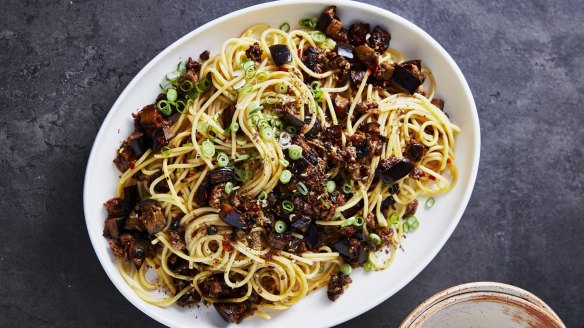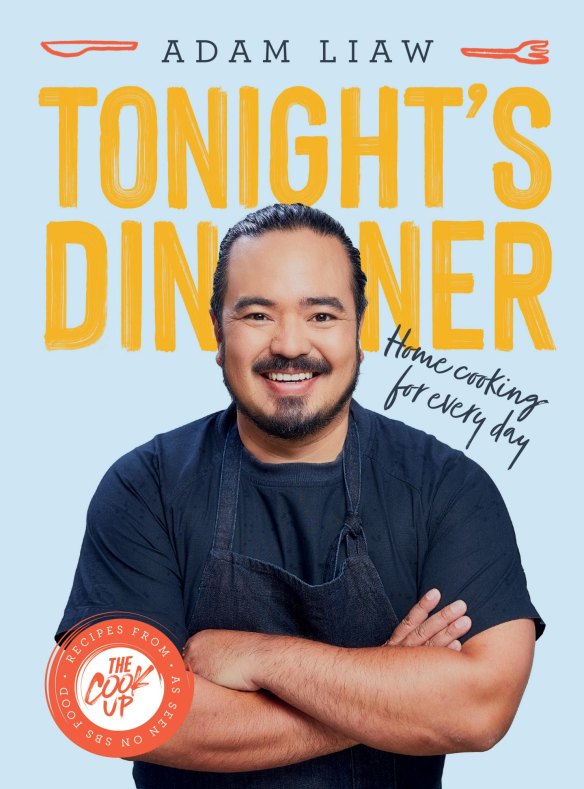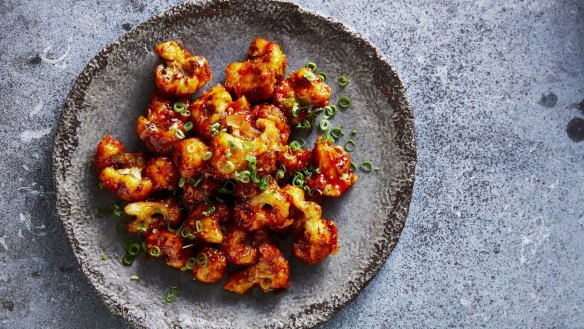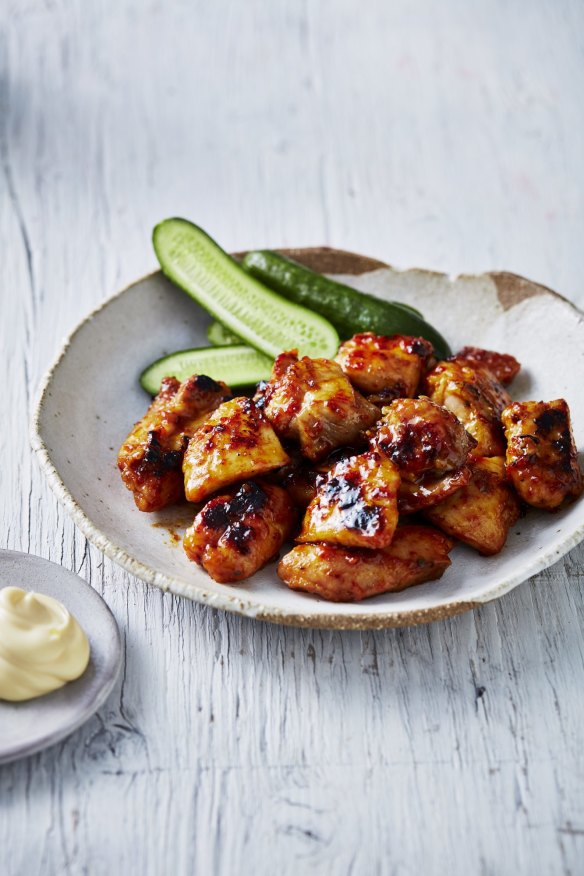Four recipes from Adam Liaw's new cookbook Tonight's Dinner

Good Food contributor Adam Liaw wants us to fall in love with home cooking again. Faced with an onslaught of marketing, we've allowed ourselves to believe that making nightly meals is an impossibly punishing chore. In his latest cookbook, Tonight's Dinner (based on his SBS TV series The Cook Up), Liaw's goal is to create delicious and doable dishes that busy people can easily make regularly. And if a recipe gets the thumbs up, it will be better and faster the next time around.
Mapo eggplant spaghetti

Sichuan's famous mapo tofu is truly one of the world's great dishes. In Japan, it's often adapted to use eggplant instead of tofu. I've taken things one step further and turned mapo eggplant into a pasta dish. Italian traditionalists will never forgive me – and nor will their counterparts in China.
INGREDIENTS
- 500g dried spaghetti
- 2 eggplants, cut into 1cm cubes
- ½ cup (125 ml) olive oil
- 250g minced beef
- 4 garlic cloves, roughly chopped
- 1 tbsp grated fresh ginger
- 2 tbsp doubanjiang (Sichuan chilli bean sauce)
- 2 tbsp salted black beans
- salt and sugar, to season
- 4 spring onions, finely sliced
- 1 tsp ground Sichuan pepper
METHOD
- Bring a large pot of water to the boil and salt it well. Add the spaghetti and cook according to the packet directions, but start to test for doneness about 2 minutes before the packet says it will be ready.
- While the spaghetti is cooking, microwave the eggplant uncovered for about 6 minutes.
- Heat a very large frypan over a high heat, add the oil, and fry the eggplant for about 3 minutes until browned. Add the beef and continue to fry until browned, breaking up any lumps as you go.
- Move the mixture to one side of the pan and fry the garlic and ginger for a minute or two until lightly browned. Add the doubanjiang and black beans and fry until fragrant. Season to taste with salt and sugar and mix everything together.
- When the pasta is al dente, drain it, but reserve about 1⁄4 cup (60ml) of the pasta water. Add the drained spaghetti and the pasta water to the pan. Toss to combine, then toss the spring onion through as well.
- Serve sprinkled with the Sichuan pepper.
Tip Like mushrooms, eggplant has a spongy structure that absorbs a lot of oil when fried. As that structure breaks down, the absorbed oil is released – so don't be tempted to keep adding more oil when frying eggplant, as you'll end up using way too much. Microwaving the eggplant first, as we do in this recipe, will stop it absorbing so much oil in the first place.
Serves 4

Gobi Manchurian
If I had to place bets on a style of food that is going to become enormously popular in the coming years, vegetarian Chinese would be at the top of my list. In India, Desi-Chinese cuisine has been fusing together vegetarian versions of the world's two most popular cuisines for decades – and Gobi (cauliflower) Manchurian might well be the most popular of the lot.
INGREDIENTS
- vegetable oil for deep-frying, plus extra for stir-frying
- 1 large head of cauliflower, separated into florets
- 2 garlic cloves, finely crushed
- 1 tsp grated fresh ginger
- 1 large green chilli, finely chopped
- 3 spring onions, finely sliced (white and green parts separated)
- 2 tbsp soy sauce
- 2 tbsp tomato sauce
- 2 tbsp chilli sauce
- 2 tbsp white vinegar
- 1 tsp sugar
- ½ tsp mild red chilli powder
- ¼ tsp freshly ground black pepper
Batter
- ½ cup (75g) plain flour
- 2 tbsp cornflour
- 1 tsp mild red chilli powder
- salt and black pepper, to season
METHOD
- Heat about 10cm of oil to 160C in a large saucepan.
- Mix the batter ingredients together and stir in about 1⁄2 cup (125ml) water to form a thick batter. Dredge the cauliflower in the batter and deep-fry, in batches if necessary, for about 5 minutes until crisp and browned. Set aside on a rack to drain.
- Heat a wok over a medium heat and add another 2 tablespoons of oil. Stir-fry the garlic, ginger, green chilli and the white part of the spring onions until fragrant. Reserving the green parts of the spring onion, add the remaining ingredients to the wok and toss to combine.
- Add the drained cauliflower to the wok, tossing to coat in the sauce. Remove to a plate, scatter with the spring onion greens and serve.
Tip Vegetables such as cauliflower actually deep-fry more successfully than meat in dishes like this because they release less liquid. If your fried foods are going soggy, it's usually because the juices being released from the ingredient are softening the batter from within.
Serves 4

Chicken paprikash
Not all pasta dishes are Italian, and not all noodle dishes are Chinese. This Hungarian comfort food could be described as a cousin to beef stroganoff, and combines chicken braised in a creamy paprika-based sauce with buttered pasta.
INGREDIENTS
- 50g butter, plus 25g extra for the pasta
- 1 onion, diced
- 1 green capsicum, diced
- 5 garlic cloves, sliced
- 2 tbsp tomato paste
- 1 kg boneless, skinless chicken thighs
- 1 tbsp plain flour
- 2 tbsp sweet paprika
- 2 cups (500ml) chicken stock
- 150g sour cream
- 500g dried orecchiette or other short pasta
- 1 tbsp finely shredded parsley
- black pepper, to serve
METHOD
- Heat a large flameproof casserole dish over a medium heat.
- Add the butter, onion and capsicum and fry for about 5 minutes until the onion has softened. Add the garlic and fry for a further 2 minutes until fragrant. Stir in the tomato paste to combine.
- Toss the chicken in the flour and add to the pan, along with the paprika, stirring to coat the chicken in the capsicum mixture.
- Stir in the stock and bring to a simmer, then simmer uncovered for 15 minutes until the chicken is cooked and the sauce has thickened. Stir the sour cream through.
- While the chicken is simmering, cook the pasta according to the packet directions, but test for doneness about 2 minutes before the packet says it will be ready. When the pasta is al dente, drain and toss the extra butter through.
- Serve the chicken alongside the pasta, sprinkled with the parsley and a grinding of black pepper.
Tip While the "mantecare" – the process of mixing the finished pasta and sauce together (often with a bit of pasta water) to emulsify – is important for many pasta dishes, there are many (even in Italian cuisine) where the sauce should be served separately. I've been told that a thick ragu should be served on top of the pasta (often tagliatelle) instead of being mixed through, and I do the same with meatballs, too.
Serves 4

Peri-yaki chicken
It's not teriyaki chicken, and it's not peri-peri chicken. This combination of Portuguese peri-peri with Japanese teriyaki is a fusion that makes surprising sense. Just think of it as a spicy teriyaki chicken.
INGREDIENTS
- 4 boneless chicken thigh fillets
- 1 tbsp cornflour
- 1 tbsp vegetable oil
- ¼ cup (60ml) teriyaki sauce (see below)
- ¼ cup (60ml) peri-peri sauce (see below)
- 4 Lebanese (short) cucumbers, cut in half lengthways
- Japanese mayonnaise, to serve
METHOD
- Cut the chicken into 5cm pieces and dust with the cornflour.
- Heat a frypan over a high heat and add the oil. Fry the chicken for 3-5 minutes until lightly browned all over.
- Add the teriyaki and peri-peri sauces and toss for a few minutes more until the chicken is cooked and the sauce is reduced, thick and coating the chicken.
- Serve with the cucumber and Japanese mayonnaise.
Tip This is essentially three recipes in one. For teriyaki chicken, use teriyaki sauce only. For a pan-fried home-style version of peri-peri chicken, use the peri-peri sauce – or go for the combination. Home cooking is all about versatility.
Serves 4
This recipe is always in my pantry. It's perfect for reducing down to glaze chicken, salmon, tofu and the like, or to use in stir-fried dishes.
INGREDIENTS
- 1 cup (250ml) light soy sauce
- 200ml mirin
- 200ml sake
- 60g caster sugar
METHOD
- Mix the ingredients together in a small saucepan over a low heat, just until the sugar has dissolved.
- Transfer to an empty bottle and seal. The sauce will keep for years in the pantry, but I promise you'll use it long before then.
Makes 650ml
Yes, you can buy this sauce in a bottle, but it is so very easy to make, and taste much better when you do. Try this one on a roast chicken (even just a roast chicken from the supermarket), chicken wings, fish, lamb chops, ribs, pumpkin or cauliflower, just to name a few options.
INGREDIENTS
- 1 red onion, roughly chopped
- 5 garlic cloves, peeled
- 4 long red chillies (or bird's eye chillies), seeded
- 1 red capsicum, cut into chunks
- 1 tomato, roughly chopped
- 2 tablespoons olive oil
- grated zest and juice of 1 lemon
- 2 tbsp red-wine vinegar
- 1 tbsp sugar
- 2 tsp salt
- 1 tsp freshly cracked black pepper
- 1 dried bay leaf
- 2 tsp dried oregano
- 1 tsp smoked paprika
METHOD
- Heat your oven to 200C fan-forced (220C conventional). Place the onion, garlic, chilli, capsicum and tomato on a lined baking tray and bake for 20 minutes. Allow to cool to room temperature.
- Transfer to a blender, add the remaining ingredients and blend to a very smooth sauce.
- The sauce will keep for a week or two in the fridge in this state,but if you want to keep it for longer, you can simmer and reduce the sauce for about 15 minutes to concentrate it before storing.
Tip I prefer to keep sauces like this and the teriyaki sauce opposite in their unreduced form, as it gives you the option to cook dishes with the sauce, but for convenience, it can be easier to reduce this sauce so that you can use it more as a condiment.
Makes 300ml
This is an edited extract from Tonight's Dinner by Adam Liaw, published by Hardie Grant Books and SBS, RRP $45. Photography: Steve Brown. Set photography: Bruce Walters. Buy now
Appears in these collections
From our partners
Original URL: https://www.smh.com.au/goodfood/four-recipes-from-adam-liaws-new-cookbook-tonights-dinner-20211014-h1z6nx.html
